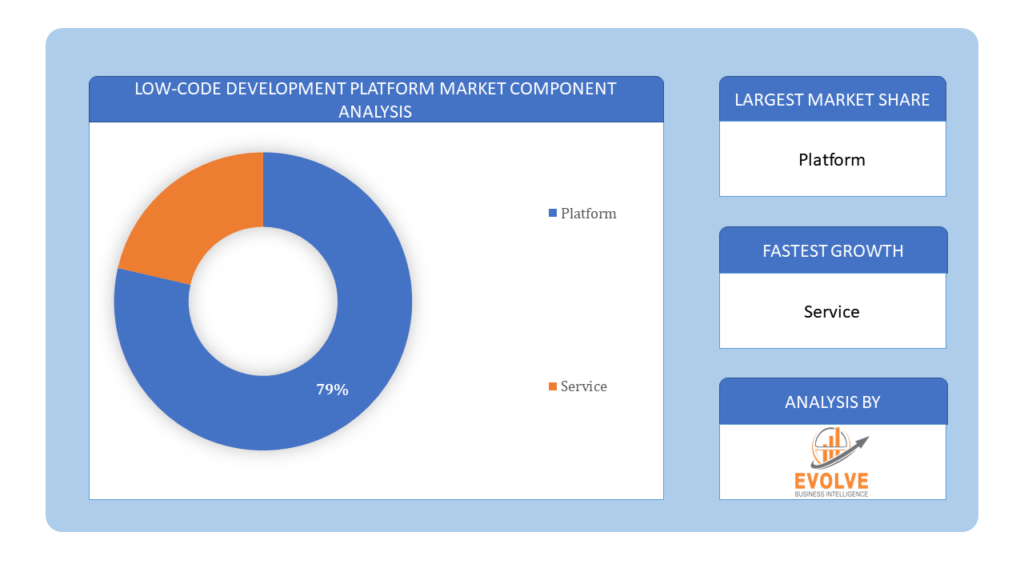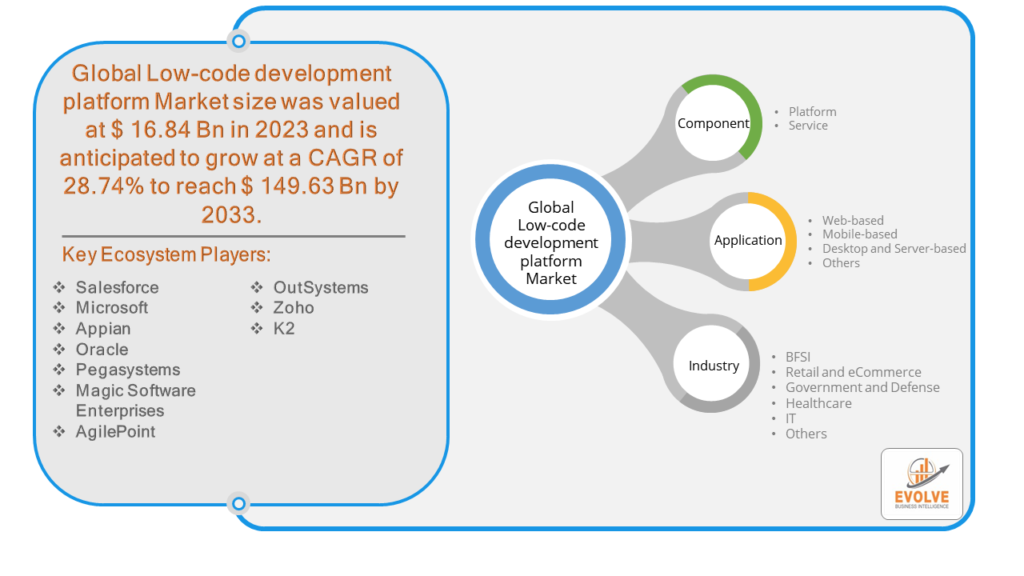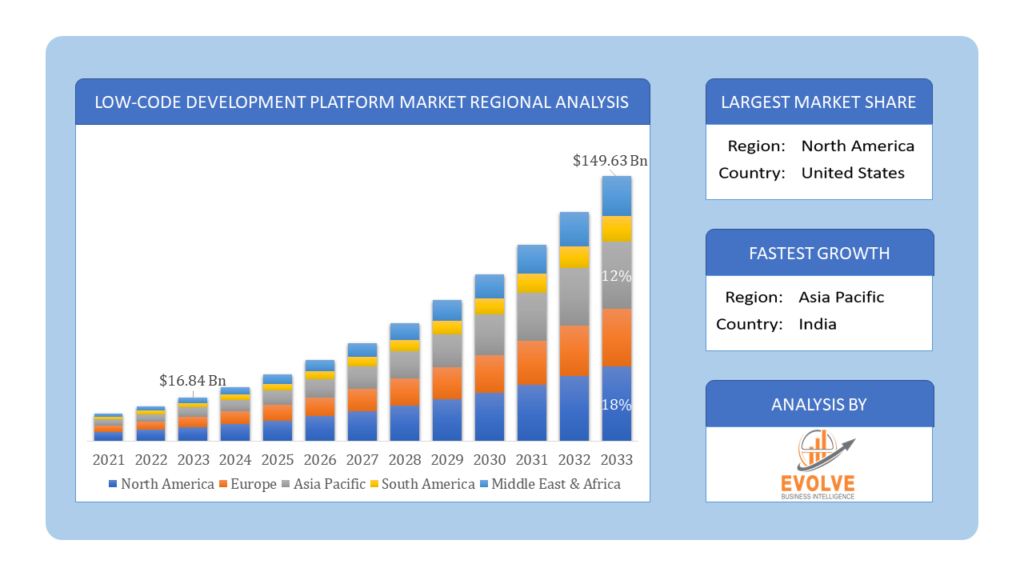Low-code development platform Market Overview
The Low-code development platform Market Size is expected to reach USD 149.63 Billion by 2033. The Low-code development platform industry size accounted for USD 16.84 Billion in 2023 and is expected to expand at a compound annual growth rate (CAGR) of 28.74% from 2023 to 2033. Low-code development platforms are software development environments that enable the rapid creation of applications with minimal hand-coding.They have gained popularity for addressing urgent market demands for software applications, combining rigorous requirements specifications with low-code platforms for rapid development of software business applications. Low-code platforms offer a visual interface for designing applications, allowing developers to drag and drop components, connect them, and configure their properties. This approach significantly speeds up the development process, reduces the need for extensive programming knowledge, and allows for the creation of custom software solutions tailored to specific business need. Low-code platforms can be used for a wide range of applications, from simple business processes to complex enterprise systems. They often include features such as model-driven development, reusable components, and automated code generation, which further streamline the development process and improve the quality of the resulting applications.
Global Low-code development platform Market Synopsis
The Low-code development platform market experienced a positive impact due to the COVID-19 pandemic. The COVID-19 pandemic has caused supply chain hiccups, which have decreased demand or created shortages in the market for low-code development platforms. Spending by consumers and businesses has decreased significantly as a result of the travel restrictions and social distancing measures, and this trend is expected to persist for some time. The epidemic has altered end-user trends and tastes, leading manufacturers, developers, and service providers to implement several measures in an attempt to stabilize their businesses.
Global Low-code development platform Market Dynamics
The major factors that have impacted the growth of Low-code development platform are as follows:
Drivers:
⮚ Reduced Costs
By automating repetitive tasks and simplifying the development process, low-code platforms can significantly reduce development costs. This cost-effectiveness is particularly attractive for small to medium-sized businesses with limited resources.
Restraint:
- Security Risks
Rapid development and deployment through low-code platforms can sometimes lead to oversight in security best practices. Vulnerabilities such as insecure configurations, inadequate authentication mechanisms, and data leakage may pose significant security risks to applications built using low-code platforms.
Opportunity:
⮚ Expansion into New Markets
Low-code platforms have the potential to expand into new markets beyond software development. They can be utilized for building mobile apps, IoT solutions, business process automation, and even citizen-centric applications for government services. This expansion opens up new revenue streams and opportunities for growth.
Low-code development platform Market Segment Overview
By Component
 Based on the Component, the market is segmented based on Platform and Service. Platforms provide the core infrastructure and tools for building applications, while services encompass consulting, training, and support to optimize platform usage and application development processes. This segmentation reflects the comprehensive offerings tailored to meet varying needs and preferences within the low-code development landscape.
Based on the Component, the market is segmented based on Platform and Service. Platforms provide the core infrastructure and tools for building applications, while services encompass consulting, training, and support to optimize platform usage and application development processes. This segmentation reflects the comprehensive offerings tailored to meet varying needs and preferences within the low-code development landscape.
By Application
Based on the Application, the market has been divided into Web-based, Mobile-based, Desktop and Server-based and Others. This segmentation reflects the diverse range of platforms catering to specific deployment environments and device types, offering tailored development solutions for various software applications and use cases.
By Industry
Based on Industry, the market has been divided into BFSI, Retail and eCommerce, Government and Defense, Healthcare, IT and Others. Because it places so much focus on software development and digital transformation, the IT and telecommunications industry leads the minimal code development platform market. Agile and effective application development procedures are critical to this industry’s ability to adapt to changing client needs and maintain its competitiveness.
Global Low-code development platform Market Regional Analysis
Based on region, the market has been divided into North America, Europe, Asia-Pacific, the Middle East & Africa, and Latin America. The area of North America is anticipated to dominate the market for the usage of Generative AI, followed by those in Asia-Pacific and Europe.
 Low-code development platform North America Market
Low-code development platform North America Market
North America dominates the Low-code development platform market due to several factors. The market for low code development platforms will be dominated by North America because to a rise in the number of people who use cardiovascular devices and are obese. Furthermore, the expansion of well-established fitness centers and health clubs would support the growth of the market in this region.
Low-code development platform Asia Pacific Market
The Asia-Pacific region has been witnessing remarkable growth in recent years. From 2023 to 2032, the Asia-Pacific Low Code Development Platform Market is anticipated to develop at the fastest rate. This is brought on by growing per capita disposable income and increased knowledge of nutrition and a healthy lifestyle. In addition, the low code development platform market in China had the most market share, while the low code development platform market in India had the quickest rate of growth in the Asia-Pacific area
.Competitive Landscape
The competitive landscape includes key players (tier 1, tier 2, and local) having a presence across the globe. Companies such as Salesforce, Microsoft, APPIAN, Oracle, and Pegasystems are some of the leading players in the global Low-code development platform Industry. These players have adopted partnership, acquisition, expansion, and new product development, among others as their key strategies.
Key Market Players:
- Salesforce
- Microsoft
- APPIAN
- Oracle
- Pegasystems
- Magic Software Enterprises
- AgilePoint
- OutSystems
- Zoho
Key development:
In March 2023: Microsoft has recently extended its generative AI capabilities to the Power Platform and introduced Dynamics 365 Copilot for multiple business sectors. This expansion offers users enhanced access to advanced AI tools and enables CIOs to evaluate technological risks and opportunities. By integrating AI models into the Power Platform’s low-code developer tool and the Dynamics 365 applications, workers can significantly enhance their productivity.
Global Low-code development platform Market, by Component
- Platform
- Service
Global Low-code development platform Market, by Application
- Web-based
- Mobile-based
- Desktop and Server-based
- Others
Global Low-code development platform Market, by Industry
- BFSI
- Retail and eCommerce
- Government and Defense
- Healthcare
- IT
- Others
Global Low-code development platform Market, by Region
- North America
- US
- Canada
- Mexico
- Europe
- UK
- Germany
- France
- Italy
- Spain
- Benelux
- Nordic
- Rest of Europe
- Asia Pacific
- China
- Japan
- South Korea
- Indonesia
- Austalia
- Malaysia
- India
- Rest of Asia Pacific
- South America
- Brazil
- Argentina
- Rest of South America
- Middle East & Africa
- Saudi Arabia
- UAE
- Egypt
- South Africa
- Rest of Middle East & Africa
| Parameters | Indicators |
|---|---|
| Market Size | 2033: $149.63 Billion |
| CAGR | 28.74% CAGR (2023-2033) |
| Base year | 2022 |
| Forecast Period | 2023-2033 |
| Historical Data | 2021 |
| Report Coverage | Revenue Forecast, Competitive Landscape, Growth Factors, and Trends |
| Key Segmentations | Component, Application, Industry |
| Geographies Covered | North America, Europe, Asia-Pacific, Latin America, Middle East, Africa |
| Key Vendors | Salesforce, Microsoft, APPIAN, Oracle, Pegasystems, Magic Software Enterprises, AgilePoint, OutSystems, Zoho, K2. |
| Key Market Opportunities | • Ongoing Trends for Digitization in the IT Industry |
| Key Market Drivers | • Digital Business Acceleration Driving Application Delivery |
REPORT CONTENT BRIEF:
- High-level analysis of the current and future Low-code development platform Industry trends and opportunities
- Detailed analysis of current market drivers, restraining factors, and opportunities analysis in the future
- Historical market size for the year 2021, and forecast from 2023 to 2033
- Low-code development platform market share analysis for each segment
- Competitor analysis with a comprehensive insight into its product segment, financial strength, and strategies adopted.
- Identifies key strategies adopted by the key players including new product development, mergers and acquisitions, joint ventures, collaborations, and partnerships.
- To identify and understand the various factors involved in the global Low-code development platform market affected by the pandemic
- To provide year-on-year growth from 2022 to 2033
- To provide short-term, long-term, and overall CAGR comparison from 2022 to 2033.
- Provide Total Addressable Market (TAM) for the Global Low-code development platform Market.









